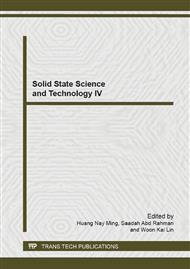[1]
H. P. S. Abdul Khalil, A. H. Bhat, and A. F. IreanaYusra: Carbohydrate Polymers 87(2), (2011), pp.963-979.
Google Scholar
[2]
P. K. Das, D. Nag, S. Debnath, and L. K. Nayak: Indian Journal of Traditional Knowledge 9(2), (2010), pp.386-393.
Google Scholar
[3]
S. Thomas, S. A. Paul, L.A. Photan, and Deepa, in: Natural Fibres: Structure, Properties and Applications, edited by S. Kalia, B. S. Kaith, and I. Kaur, Cellulose Fibres: Bio- and nano- Polymer Composites, chapter, 1, Springer- Verlag Berlin Heidelberg (2011).
DOI: 10.1007/978-3-642-17370-7_1
Google Scholar
[4]
N. Kengkhetkit and T. Amornsakchai: Industrial Crops and Products 40 (2012), pp.55-61.
Google Scholar
[5]
M. Nuruddin, A. Chowdhury, S. A. Haque, M . Rahman, S. F. Farhad, M. SarwarJahan and A. Quaiyyum: Cellulose Chemistry and Technology 45(5-6), (2011), pp.347-354.
Google Scholar
[6]
P. M. Visakh and S. Thomas: Waste Biomass Valor 1 (2010), pp.121-134.
Google Scholar
[7]
Y. Habibi, L. A. Lucia, and O. J. Rojas: Chemical Reviews 110 (6), (2010), pp.3479-3500.
Google Scholar
[8]
S. M. Sapuan, A. R. Mohamed, J. P. Siregar, and M. R. Ishak: Pineapple Leaf Fibres and PALF-Reinforced Polymer Composites, edited by S. Kalia, B. S. Kaith, and I. Kaur, Cellulose Fibres: Bio- and nano- Polymer Composites, chapter, 12, Springer- Verlag Berlin Heidelberg (2011).
DOI: 10.1007/978-3-642-17370-7_12
Google Scholar
[9]
P. S. Mukherjee and K. G. Satyanarayana: Journal of Materials Science 21 (1986), pp.51-56.
Google Scholar
[10]
B. M. Cherian, A. L. Leao, S. F. De Souza, S. Thomas, L. A. Pothan and, M. Kottaisamy: Carbohydrate Polymers 81 (2010), pp.720-725.
DOI: 10.1016/j.carbpol.2010.03.046
Google Scholar
[11]
W. Li, R. Wang, and S. Liu: Bioresourse. com 6 (4), (2011), pp.4271-4281.
Google Scholar
[12]
X. J. Jin and D. P. Kamdem: Cellulose Chemistry and Technology 43(7-8), (2009), pp.229-234.
Google Scholar
[13]
E. Dinand, M. Vignon, H. Chanzy, and L. Heux: Cellulose 9(2002), pp.7-18.
DOI: 10.1023/a:1015877021688
Google Scholar


